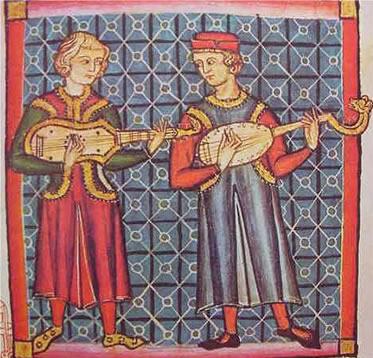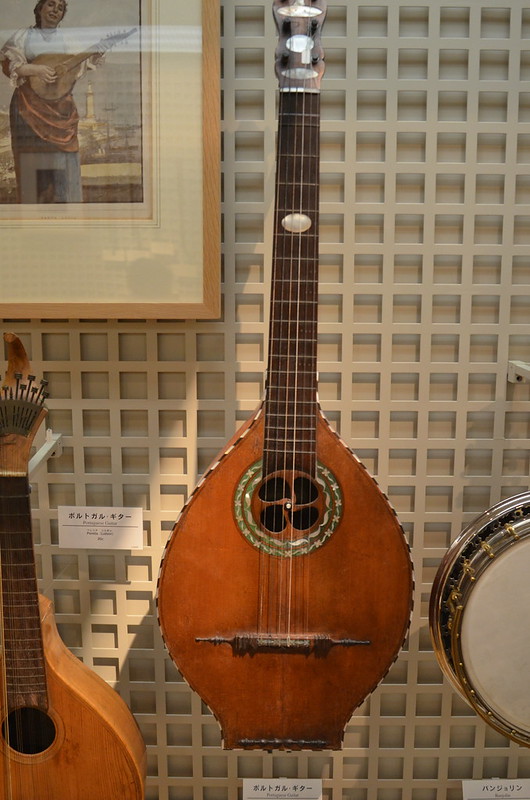lute
LEXIS
In musicology, lute is a collective term for all musical instruments that have a body and strings. A subset of these are necked lutes in which the strings are carried by a stalk called neck. The necked lutes are further distinguished in shell-necked lutes, whose resonance-body is a natural or carved shell, and box-necked lutes, in which the resonance-body consists of a box with sides. These include all types of guitars, but also violins. 1) An ukulele is therefore also a box-necked lute. The common origin of all these stringed instruments can still be found in the English and French job title luthier, which literally means „builder of lutes“.
Early History
Mesopotamia and EgyptIn royal tombs in the Sumerian Ur, harps from about 2500 BC have been discovered as the oldest examples of technically perfect stringed instruments. In Uruk a clay tablet from about 2400 BC with the oldest image of a lute was found.2) The Sumerian long-necked lute was flat, almond or pear-shaped, possessed one to two strings, no peg and was played with a pick.
When the Hyksos conquered Egypt about 1700 BC, they brought from Mesopotamia up to 120 cm long three-string long-necked lutes. It stayed there even after the liberation of the country. There were also smaller forms of the lute, some already had a waist. They had four to eight sound holes. The strings were fixed at the end of the stem in a stringholder.3) In the 1st mill. AD, short-necked lutes originated in Egypt. However, these were intended for the use of the lower classes and children:
One should realize that this „piccolo“ lute was an instrument of the lower classes, beggars, jugglers, or was played by children.4)
Barbat and Oud
India, Persia, Central Asia, ArabiaSimilar types were spreading at the same time in India, Persia and Central Asia. But in Central Asia about 500 BC for the first time pegs were used. From there, these lute forms migrated to China. At the time of the Sassanids (224–651 AD) Persia produced short-necked lutes with pegs and angled necks (they called the three-stringed lute mizahr and the four-stringed barbat). From this, the Arabs then developed their lute called oud (= „wood“). It migrated to China (where it was known as pipa) and Japan (biwa). In the 4th to 8th centuries, the Christian Copts in Egypt developed a lute which was in principle a guitar. It was brought to Africa and Western Europe after the Arab conquest of Egypt along with oud and rebab (slightly smaller than the oud and played with a bow). 5)
After: Musikinstrumentenmuseum Hamamatsu, Japan
Middle Ages
Moorish and Latin GuitarAfter the Arab conquest of Spain in the 8th century, these musical instruments also found their way into Western music. There are numerous descriptions of lutes at the Carolingian court, which correspond almost unchanged to the oud. They have no or several sound holes. However, in the illustrations of the Candigas de Santa Maria (Marian songs, 1257–1275), the Moorish and the Latin guitar (quitarra) appear in addition to the great Sassanid lute. The Moorish Guitar had eight strings, a half-almond body and no [bund|frets]]. The Latin Guitar had a „tub-shaped“ chest with waist, four strings and frets. Both have a single sound hole in the middle of the body. From these guitars stemmed the vihuela (Italian: viola). It was plucked either with the plectrum or played with the bow. The word guitar itself, however, comes from the Greek kithara, because the new instruments were conveyed to Europe via the Greek world power Byzantium. In addition, Emperor Frederick II brought Arabian musicians to his court in Sicily in the 12th century, and their instruments spread from there as well.
From now on, the ways of lute and guitar separate.
The Lute originally had only four frets, from the 13th century seven, from the 17th century ten and from the 18th century twelve. Its body is half-pear-shaped. The top was initially almond-, later egg- and last pear-shaped. At first, the bridge sat far down on the top and later moved up and up. This resulted in mandoras and finally mandolines. The guitar developed from the Latin guitar had either four strings or four double courses (which were tuned in unison). The most common tuning in the 13th and 14th centuries in Spain was G–c–e–a or A–c–e–a or A–d–fb–b for large and d–f–a–d'or f–bb–d'–g or g–c'–e'–a' for small instruments.6) The latter corresponds to today's ukulele standard tuning.
Renaissance and Baroque
Finding the perfect guitar shapeIn contrast to string instruments and lutes, the guitar remained a challenge in terms of design, for which different solutions were tried:
Whereas at this time final forms and standards have been reached in violin construction, and the major types of lute had become stabilized, there were great differences of opinion about guitar-making. It became necessary to lengthen the neck considerably in order to meet the demands of professional musicians. This in turn entailed moving the bridge, which required corresponding changes in the interior construction of the body which where never wholle mastered. Not until the end of the 18th century, when the position of the octave fret was finally settled at the edge of the body could steps be taken to find a complete solution to the acoustic problems involved in guitar-making. A perfect final solution conforming to the mathematical laws of the physical principles involved has however not yet been achieved …7)
In Germany, the gittern (germ. Quinterne, ital. chiterna ) dominated in the 16th century with four choirs and a headstock borrowed from the lute as a cost-effective instrument for entertainers and private musicians.
In Italy the Baroque guitars called viola napoletana and chitarra battente were predominant, particularly in the 17th and 18th centuries , which had four or five strings and an figure-8-shaped body with only slightly defined waist.
Likewise, in England and France the courses were replaced by individual strings from the 18th century. A sixth string was added, and E–A–d–g–b–e' became the standard tuning. At the court of Weimar in 1790 an Italian five-string guitar was rebuilt into a six-string, spread throughout Germany and displaced the gittern. It prevailed in France as guitarre allemande.
As early as the 18th century the house of Hanover took over the English throne, this guitar also migrated to Britain, where it was called guittar and later became known as English guitar. It had steel strings and was very easily tuned, which is why it was often played in thirds parallel. Since it was mainly used as an accompanying instrument, the capo was used to change the tuning.
British merchants brought the English guitar to Portugal and also to Portuguese Madeira. In Portugal it has since been distributed as Portuguese guitar, which is used today in Fado music.8)
Iberian Guitars
The Figure-8-FormIn Spain and Portugal and their colonies developed the figure-8-shaped guitar with a pronounced waist, which should shape the final image of the guitar. This includes:
- Soprano guitars (span. quitarillo, port. machete de braco), 49–51 cm long, with four strings (in South America also with five as quitarillo).
- Tenor guitars (third, quart and quint guitars). They often have a sixth string.
- Bass guitars (referred to in the rest of Europe as prim guitars) as today's standard of the six-string concert guitar.
Pictures
References
- Erich M. von Hornbostel, Curt Sachs: „Systematik der Musikinstrumente. Ein Versuch“. In: Zeitschrift für Ethnologie 46, 1914 (4–5): 553–90
- Franz Jahnel: Die Gitarre und ihr Bau: Technologie von Gitarre, Laute, Mandoline, Sister, Tanbur u. Saite. Verlag Das Musikinstrument 1963 (engl.: Manual of Guitar Technology: The History and Technology of Plucked String Instruments. Bold Strummer, Westport 2000).
- Irving, M.: Colonial Counterpoint: Music in Early Modern Manila. Oxford: Oxford University Press 2010
- Jaynes, E. T.: „Origins of Musical Instruments.“ In: The Physical Basis of Music and its Implications for Musical Performance. Washington University 1996
















